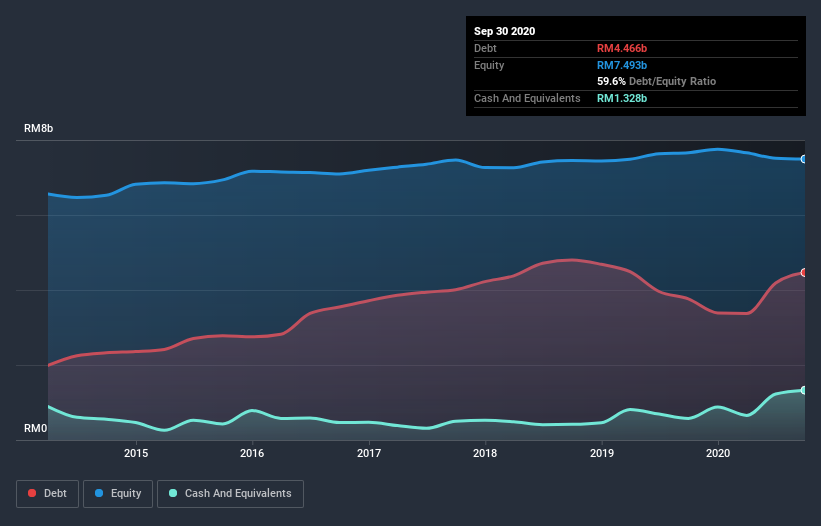- Malaysia
- /
- Real Estate
- /
- KLSE:UEMS
Here's Why UEM Sunrise Berhad (KLSE:UEMS) Is Weighed Down By Its Debt Load

The external fund manager backed by Berkshire Hathaway's Charlie Munger, Li Lu, makes no bones about it when he says 'The biggest investment risk is not the volatility of prices, but whether you will suffer a permanent loss of capital.' So it might be obvious that you need to consider debt, when you think about how risky any given stock is, because too much debt can sink a company. We can see that UEM Sunrise Berhad (KLSE:UEMS) does use debt in its business. But the real question is whether this debt is making the company risky.
When Is Debt Dangerous?
Debt and other liabilities become risky for a business when it cannot easily fulfill those obligations, either with free cash flow or by raising capital at an attractive price. If things get really bad, the lenders can take control of the business. However, a more frequent (but still costly) occurrence is where a company must issue shares at bargain-basement prices, permanently diluting shareholders, just to shore up its balance sheet. By replacing dilution, though, debt can be an extremely good tool for businesses that need capital to invest in growth at high rates of return. The first thing to do when considering how much debt a business uses is to look at its cash and debt together.
See our latest analysis for UEM Sunrise Berhad
What Is UEM Sunrise Berhad's Debt?
You can click the graphic below for the historical numbers, but it shows that as of September 2020 UEM Sunrise Berhad had RM4.47b of debt, an increase on RM3.76b, over one year. On the flip side, it has RM1.33b in cash leading to net debt of about RM3.14b.

How Strong Is UEM Sunrise Berhad's Balance Sheet?
The latest balance sheet data shows that UEM Sunrise Berhad had liabilities of RM3.10b due within a year, and liabilities of RM3.37b falling due after that. On the other hand, it had cash of RM1.33b and RM797.1m worth of receivables due within a year. So its liabilities total RM4.34b more than the combination of its cash and short-term receivables.
This deficit casts a shadow over the RM2.43b company, like a colossus towering over mere mortals. So we'd watch its balance sheet closely, without a doubt. After all, UEM Sunrise Berhad would likely require a major re-capitalisation if it had to pay its creditors today.
In order to size up a company's debt relative to its earnings, we calculate its net debt divided by its earnings before interest, tax, depreciation, and amortization (EBITDA) and its earnings before interest and tax (EBIT) divided by its interest expense (its interest cover). This way, we consider both the absolute quantum of the debt, as well as the interest rates paid on it.
Weak interest cover of 1.5 times and a disturbingly high net debt to EBITDA ratio of 15.8 hit our confidence in UEM Sunrise Berhad like a one-two punch to the gut. This means we'd consider it to have a heavy debt load. Worse, UEM Sunrise Berhad's EBIT was down 56% over the last year. If earnings continue to follow that trajectory, paying off that debt load will be harder than convincing us to run a marathon in the rain. The balance sheet is clearly the area to focus on when you are analysing debt. But ultimately the future profitability of the business will decide if UEM Sunrise Berhad can strengthen its balance sheet over time. So if you're focused on the future you can check out this free report showing analyst profit forecasts.
But our final consideration is also important, because a company cannot pay debt with paper profits; it needs cold hard cash. So we clearly need to look at whether that EBIT is leading to corresponding free cash flow. Over the last three years, UEM Sunrise Berhad actually produced more free cash flow than EBIT. There's nothing better than incoming cash when it comes to staying in your lenders' good graces.
Our View
To be frank both UEM Sunrise Berhad's EBIT growth rate and its track record of staying on top of its total liabilities make us rather uncomfortable with its debt levels. But on the bright side, its conversion of EBIT to free cash flow is a good sign, and makes us more optimistic. Overall, it seems to us that UEM Sunrise Berhad's balance sheet is really quite a risk to the business. For this reason we're pretty cautious about the stock, and we think shareholders should keep a close eye on its liquidity. When analysing debt levels, the balance sheet is the obvious place to start. However, not all investment risk resides within the balance sheet - far from it. For instance, we've identified 2 warning signs for UEM Sunrise Berhad (1 is concerning) you should be aware of.
If you're interested in investing in businesses that can grow profits without the burden of debt, then check out this free list of growing businesses that have net cash on the balance sheet.
If you decide to trade UEM Sunrise Berhad, use the lowest-cost* platform that is rated #1 Overall by Barron’s, Interactive Brokers. Trade stocks, options, futures, forex, bonds and funds on 135 markets, all from a single integrated account. Promoted
New: AI Stock Screener & Alerts
Our new AI Stock Screener scans the market every day to uncover opportunities.
• Dividend Powerhouses (3%+ Yield)
• Undervalued Small Caps with Insider Buying
• High growth Tech and AI Companies
Or build your own from over 50 metrics.
This article by Simply Wall St is general in nature. It does not constitute a recommendation to buy or sell any stock, and does not take account of your objectives, or your financial situation. We aim to bring you long-term focused analysis driven by fundamental data. Note that our analysis may not factor in the latest price-sensitive company announcements or qualitative material. Simply Wall St has no position in any stocks mentioned.
*Interactive Brokers Rated Lowest Cost Broker by StockBrokers.com Annual Online Review 2020
Have feedback on this article? Concerned about the content? Get in touch with us directly. Alternatively, email editorial-team (at) simplywallst.com.
About KLSE:UEMS
UEM Sunrise Berhad
An investment holding company, engages in the township and property development business in Malaysia, Australia, Singapore, and South Africa.
Solid track record with moderate growth potential.
Market Insights
Community Narratives



